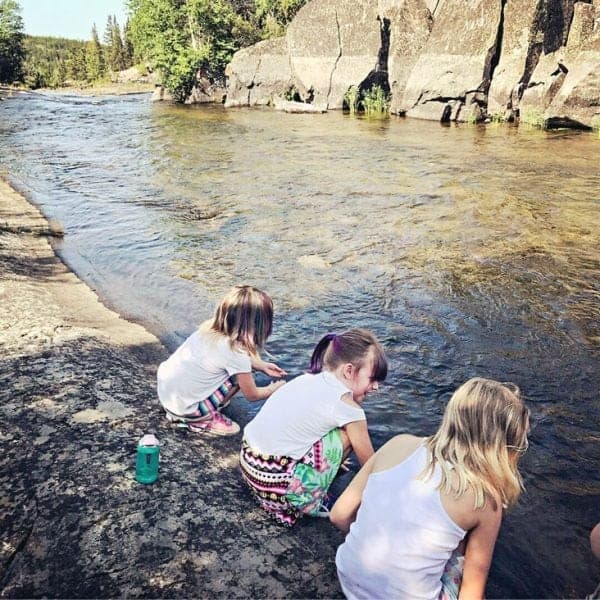Last Tuesday we hiked to Cameron Falls, located in Hidden Lake Territorial Park, on the Ingraham Trail, approximately 47 kilometres east of Yellowknife.
It was my daughters', ages eight, seven, and five, first time doing a rugged nature hike. I thought my youngest, Harper would struggle with some of the more uneven trail, but she surprised me with her grit and managed to hike back unaided.

When we reached the falls, which inspired questions about where the water comes from and goes to, the girls recognized an element of danger standing on the cliff for a picture of the falls behind them. They stayed close to the benches on site and collected rocks. We proceeded to hike to the shore of the river, behind the falls, and they crouched at the bank, hands dipped in the cool water.
The hike left me wondering if residents here appreciate how fortunate they are to expose their children to the wonders of nature on a regular basis. The gift of living in the North is the easy accessibility of nature, and the opportunity to engage in on the land learning, especially for children.
In my opinion, the North lends itself to an outdoor life unavailable anywhere else, and Northerners have a special understanding and appreciation of nature. The North still has a frontier culture of connection to the land, which is likely due to it being the last part of Canada to be settled. Traditions of living off the land are still part of people’s lifestyle; outdoor skills have not been lost to urbanization.
When I was researching summer camps to register my daughters in, I was pleasantly surprised by the diversity, and how most of the camps incorporate the outdoors. And, contrary to everything costing more in the North, the summer camps are affordable, averaging $225 to $300 per child per week.
For example, there is Young Explorers yoga and nature camp for ages six to 12, a sailing school for ages seven to 14 and a Bushkids camp for ages five to 11. There’s also a Dangerous Camp 4 Kids for ages 10 to 13, which allows kids to take supervised risks such as “make fires without matches, use power tools, climb trees, build shelters, make improvised weapons and traps and learn basic first aid.”
The theme of these camps, nature as the ultimate teacher, learning the art of risk-taking, and providing spaces for natural play to exercise young bodies and imaginations, is becoming a lost way of life for our younger generations.
The novel, Last Child in the Wood: Saving Our Children from Nature-Deficit Disorder by Richard Louv states technology such as iPad/iPhones or anything with a screen has interfered with healthy childhood development.
Louv states: “Nature-deficit disorder describes the human costs of alienation from nature, among them: diminished use of the senses, attention difficulties, and higher rates of physical and emotional illness.”
In particular, he highlights the rise in childhood obesity, the over diagnosis of ADHD, and the increasing rates of childhood depression.
In relation to the dangers of being a plugged in generation, the World Health Organization has recently identified video game addiction as a mental health problem.
Louv states that exposing children to nature is fundamental to their development. Not only is nature a “healing balm for the emotional hardships in a child’s life,” it also inspires creativity, allows children to learn independence, and teaches them how to trust their instincts.
This week I registered my girls in Saxifrage Studio’s Art Camp, run by local artist and art teacher, Tracey Bryant. It includes a morning outdoor excursion, picnic lunch, free play and an afternoon in studio art lesson.
On Monday afternoon when I picked them up they had collected a variety of leaves and were painting them. When my daughter, Harper asked if she could watch TV after she was done her painting, Tracey smiled, and said, “No, we don’t do that unless it’s raining.”
As a parent that sometimes relies on the iPad to help me make it through the day, I can tell you that Yellowknife has made it easier to get outside.
While there are many reasons to lament living in the North, such as the high cost of living or the isolation from services, there are things you can do here that don’t cost money that you can’t do in a city. There are invaluable outdoor experiences that shape the essence of this population.
The immersion of kids in nature makes for more well-rounded, and imaginative citizens with a healthy respect for risk-taking and good environmental stewardship. I believe the kids raised in the Northwest Territories are going to be our future change makers and innovators, all due to the fact that they are exposed to nature.
